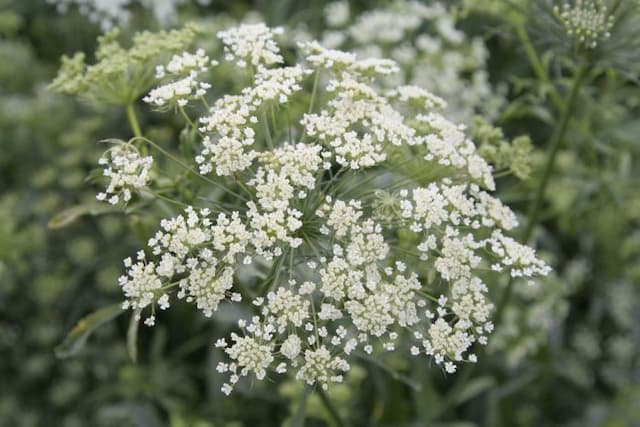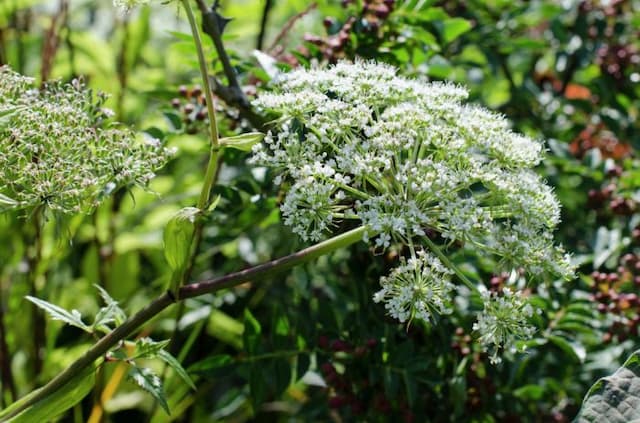Cilantro Coriandrum sativum 'Confetti'

ABOUT
Coriandrum sativum 'Confetti' is a variety of cilantro, also known as coriander, characterized by its unique, delicate appearance. It features a profusion of finely divided, feathery foliage that takes on a soft, almost ruffled look, creating a lighter, lacier texture compared to the standard cilantro. The leaves are a bright green that can add a fresh visual appeal to a garden setting. When it blooms, the plant produces small, white to pale pink flowers that cluster in umbrella-like formations called umbels. These blooms can attract beneficial insects to the garden. The overall impression of 'Confetti' is one of an airy and decorative herb that mirrors the look of traditional cilantro while offering a whimsical twist on leaf shape and texture.
About this plant
 Names
NamesSynonyms
Coriander, Cilantro, Chinese Parsley, Dhania.
Common names
Coriandrum sativum
 Toxicity
ToxicityTo humans
Cilantro 'Confetti' is not toxic to humans. It is commonly used as a culinary herb, and all parts of the plant can be ingested without fear of toxicity.
To pets
Cilantro 'Confetti' is also not toxic to pets. It is safe for cats and dogs, and ingesting this plant should not cause any symptoms of poisoning or adverse health effects.
 Characteristics
CharacteristicsLife cycle
Annuals
Foliage type
Deciduous
Color of leaves
Green
Flower color
White
Height
1-2 feet (30-60 cm)
Spread
1 foot (30 cm)
Plant type
Herb
Hardiness zones
2-11
Native area
Mediterranean
Benefits
 General Benefits
General Benefits- Culinary Use: Coriander 'Confetti' is widely used for its aromatic leaves in cooking, adding a fresh, citrusy flavor to dishes.
- Garden Aesthetics: The 'Confetti' variety, with its unique, fine-cut foliage, adds texture and visual interest to garden beds and containers.
- Attracts Pollinators: Coriander 'Confetti' flowers can attract beneficial insects, such as bees and butterflies, to the garden.
- Companion Planting: Planting coriander can benefit neighboring plants by deterring harmful pests and promoting a healthy growing environment.
- Herbal Freshness: Coriander leaves can be used to garnish and add a burst of freshness to salads, soups, and salsas.
- Easy to Grow: This herb is relatively easy to cultivate in a range of soil types, as long as it has good drainage and adequate sunlight.
- Continuous Harvest: Regularly harvesting the leaves promotes further growth, providing a continuous yield throughout the growing season.
 Medical Properties
Medical Properties- Antioxidant: Coriander contains antioxidants that can help protect cells from damage caused by free radicals.
- Digestive Aid: It is traditionally used to help soothe an upset stomach and relieve indigestion and flatulence.
- Anti-diabetic: Some studies suggest that coriander might help in lowering blood sugar levels.
- Antibacterial: The essential oils in coriander have shown antibacterial properties, especially against certain foodborne pathogens.
- Lipid-lowering: There is some evidence to suggest that coriander can help reduce levels of bad cholesterol (LDL) while increasing good cholesterol (HDL).
- Anti-inflammatory: Compounds in coriander, such as linoleic acid, have anti-inflammatory properties that might help reduce inflammation in the body.
- Anxiolytic: Some animal studies indicate coriander may have mild sedative effects and could help reduce anxiety.
 Air-purifying Qualities
Air-purifying QualitiesThis plant is not specifically known for air purifying qualities.
 Other Uses
Other Uses- Cilantro-flavored cocktails: The leaves of Coriandrum sativum 'Confetti' can be muddled or used as a garnish in cocktails, adding a fresh and unique herbaceous flavor.
- Coriander seed sachets: The seeds of this plant can be dried and tied into small sachets, which offer a natural way to fragrance drawers and closets.
- Botanical dye: The flowers and leaves of cilantro can be used in producing natural dyes for fabrics, yielding various shades of green and yellow.
- Natural pest repellent: Cilantro plants can be used in gardens to repel aphids, potato beetles, and other harmful insects, protecting nearby plants.
- Flavoring agent in pickling: The leaves and seeds of Coriandrum sativum 'Confetti' can be added to the pickling process for cucumbers, carrots, and other vegetables, infusing them with its distinct flavor.
- Homemade potpourri: Dried cilantro leaves and seeds can be mixed with other dried flowers and spices to create a unique, fragrant potpourri.
- Garnish for desserts: Fresh cilantro leaves can provide an unexpected but delightful garnish for certain sweet dishes, especially those with a citrus or tropical flavor profile.
- Vegetable companion planting: Planting cilantro near tomatoes, peppers, and beans can help enhance their growth and flavor because it attracts beneficial insects that assist pollination.
- Culinary education tool: Cilantro's distinctive flavor makes it an excellent plant for taste education, helping to acquaint individuals with the broad spectrum of herbal tastes.
- Cilantro-infused oil: The leaves can be used to make a cilantro-infused oil, perfect for drizzling over salads, pastas, or bruschetta to add an extra depth of flavor.
Interesting Facts
 Feng Shui
Feng ShuiThe plant Cilantro is not used in Feng Shui practice.
 Zodiac Sign Compitability
Zodiac Sign CompitabilityThe plant Cilantro is not used in astrology practice.
 Plant Symbolism
Plant Symbolism- Healing: Coriander, the most common name of Coriandrum sativum 'Confetti', is associated with healing due to its various medicinal properties that have been recognized historically in herbal medicine.
- Protection: It's often believed to possess protective qualities, whereby people would use it to ward off evil and disease.
- Love: In some folklore, coriander is associated with love and is used in love spells or given as a symbol of hidden feelings.
- Health: Due to its nutritional benefits, coriander also symbolizes good health and is often used to indicate wellness and a desire for longevity.
- Peace: The calming scent of coriander is thought to bring peace to one's home and spirit, making it a plant with tranquil connotations.
 Water
WaterCilantro 'Confetti' should be watered when the top inch of soil feels dry to the touch, typically every 3 to 5 days depending on the climate and soil drainage. It is best to water this plant early in the morning or late in the afternoon to reduce water evaporation. Apply water at the base of the plant until the soil is moistened but not waterlogged. Generally, cilantro requires about 1 inch of water per week, which translates to approximately 0.6 gallons per square foot of soil area.
 Light
LightCilantro 'Confetti' thrives in full sun to partial shade conditions. It needs around 6 to 8 hours of sunlight per day, though in extremely hot climates, some afternoon shade can be beneficial to prevent wilting. The ideal spot for planting cilantro is an area with clear exposure to morning sunlight and protection from the harsh afternoon sun.
 Temperature
TemperatureCilantro 'Confetti' prefers temperatures between 50°F and 85°F. The plant can survive minimum temperatures of around 40°F but will start bolting when temperatures rise consistently above 75°F. These ideal temperature conditions make cilantro a cool-season herb comfortable in spring and fall.
 Pruning
PruningCilantro 'Confetti' benefits from occasional pruning to encourage bushier growth and to prevent the plant from becoming leggy. Prune or pinch off the top leaves when the plant reaches about 6 inches in height, which usually happens every 3 to 4 weeks. The best time to prune is in the cooler parts of the day to minimize stress on the plant.
 Cleaning
CleaningAs needed
 Soil
SoilCilantro 'Confetti' thrives best in a well-draining, fertile soil mix with a pH between 6.2 and 6.8. A mix containing equal parts of garden soil, compost, and coarse sand or perlite is ideal to maintain the necessary balance of moisture and aeration.
 Repotting
RepottingCilantro 'Confetti' does not typically require repotting as it is a short-lived herb and often grown as an annual. Repot only if starting indoors and transplanting outside after the last frost.
 Humidity & Misting
Humidity & MistingCilantro 'Confetti' prefers moderate humidity levels but is tolerant of ordinary room humidity. Avoid overly humid conditions to prevent fungal diseases.
 Suitable locations
Suitable locationsIndoor
Place in bright, indirect light and keep soil moist.
Outdoor
Plant in full sun to partial shade, water regularly.
Hardiness zone
2-11 USDA
 Life cycle
Life cycleCoriander 'Confetti' begins its life as a seed that, when sown in fertile, well-draining soil and given adequate moisture and warmth, germinates within 7-20 days. The seedling stage follows, where paired cotyledons emerge before true leaves develop, exhibiting the distinctive lacy foliage characteristic of this cultivar. As the plant matures, it develops a rosette of leaves and then bolts, sending up a flowering stem that produces umbels of small, white to pale pink flowers, which are attractive to beneficial insects. Following pollination, these flowers set seed, which are the coriander spice, completing its reproductive cycle. If left unharvested, seeds may fall to the ground and self-sow, continuing the lifecycle. Coriander is an annual, so after setting seed, the plant typically dies, but not before it may have propagated the next generation of plants.
 Propogation
PropogationPropogation time
Spring-Early Summer
The most popular method for propagating Coriander 'Confetti', also simply known as cilantro, is through direct seeding. Cilantro seeds should be sown in the spring after the last frost when soil temperatures reach around 50-55 degrees Fahrenheit (10-13 degrees Celsius). Seeds can also be sown in the late summer for a fall harvest. Spacing is crucial, as cilantro needs room to grow - sow the seeds about 1/4 inch deep (about 6 millimeters) and space them 2 to 4 inches apart (5-10 centimeters). These plants prefer well-drained, fertile soil and a sunny location. Water regularly to keep the soil moist, but not waterlogged. Cilantro typically germinates in 7 to 10 days.








